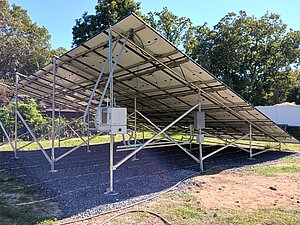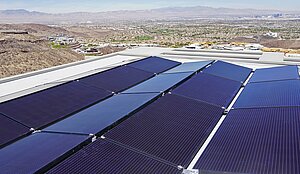

Solar Ballast Systems for PV Installations
High Performance, Attractive Pricing
Table of Contents
What is a Solar Ballast System?
A solar ballast system is a method used to secure photovoltaic (PV) installations and scaffolding against environmental forces, such as wind uplift. To keep the structure firmly in place, it is weighted down with ballast, which consists of various materials that provide stability through their weight, without penetrating the roof membrane or requiring the construction of foundations.
Materials for Solar Ballast Systems
There are several materials and methods that can be used in solar ballast systems. The most common options include:
- Concrete Blocks: These are durable and widely used in solar ballast systems. They offer significant mass and are relatively cost-effective.
- Steel Weights: More compact than concrete blocks, though generally more expensive.
- Gravel: Often used in specially designed containers, gravel in solar ballast systems adapts flexibly to ground conditions.
- Water Bags: Flexible and easy to transport, water bags can be filled on-site and are particularly suitable for temporary installations in solar ballast systems.
- Sandbags: Similar to water bags, sandbags offer flexibility and are easy to handle and position in solar ballast systems.
Determining the Right Solar Ballast System for Your PV Installation
The required ballast for a solar ballast system does not depend on individual PV modules but rather on the entire system and specific environmental factors:
- Size and Weight of PV Modules: Larger PV modules typically require more ballast because they present more surface area to the wind. Heavier modules contribute more to the ballast themselves, reducing the need for additional weights.
- Tilt Angle of the Modules: The greater the tilt angle, the more surface area the modules present to the wind, which may increase the ballast required in the solar ballast system.
- Snow and Wind Loads: In regions with strong winds or heavy snow, more ballast is needed to secure the PV system.
- Mounting Systems: The type and design of the mounting system influence the amount and placement of ballast in the solar ballast system.
- Building Height: Wind speeds increase with building height, so taller buildings may require heavier ballast in their solar ballast systems.
Calculating the Required Ballast for a Solar System
When calculating the required ballast for a solar ballast system, all the mentioned factors are considered, as well as the distance of the PV system from the roof edge. This calculation cannot be done with a simple formula or a calculator. The easiest way to determine the correct ballast is by using a planning tool:
- K2 Base assists in planning the substructure as well as the entire PV system. The data can be transferred to other planning tools from various manufacturers, making it a versatile tool for solar ballast systems.
Mounting Elements for Solar Ballast Systems
At Krannich Solar USA, we offer high-quality ballast racking solutions, including the IronRidge XR Rail Family and K2 D-Dome systems. These racking systems provide durable, efficient, and easy-to-install solutions for flat roof solar installations.
Conclusion
Solar ballast systems secure PV installations and scaffolding against displacement by wind and weather. Proper safety in a solar ballast system can only be achieved if the choice of ballast materials and the calculation of the required loads are correct. Planning tools should definitely be used for this purpose. Whether it's large commercial PV installations or small balcony power plants, if the solar ballast system is properly implemented, the structure will stay securely in place.

